Moving Files from iCloud Drive to MEGA: 4 Straightforward Methods That Work
Migrating your files from iCloud Drive to MEGA doesn’t have to be complicated. This guide explores four practical methods—from browser-based downloads to automated cloud-to-cloud tools—allowing you to transfer your data efficiently without relying on your own internet bandwidth.
Introduction
As more users operate across multiple cloud platforms, shifting files from iCloud Drive to MEGA has become an essential task—whether you're consolidating your storage, switching providers, or backing up important data. In this guide, you'll learn four reliable ways to complete the transfer: from manual browser uploads and iOS-based transfers, to advanced methods like Rclone and seamless server-to-server tools like Cloudslinker. Whether you value speed, control, or simplicity, you'll find an option that suits your workflow.
iCloud Drive is Apple’s native cloud storage offering, built right into macOS, iOS, and Windows environments. Every Apple user gets 5 GB of free space, with the ability to scale up to 12 TB via iCloud+.
- Universal Syncing: Changes made in your Mac’s Desktop or Documents folders instantly reflect across your iPhone, iPad, and even iCloud.com.
- Supports Large Files: Upload files up to 50 GB—perfect for photographers, editors, and designers.
- Flexible Access: Use Finder on Mac, Files app on iOS, or File Explorer on Windows to browse and manage your files.
- Live Sharing: Collaborate on files and folders with granular permission control.
- End-to-End Privacy: With features like Advanced Data Protection and secure encryption, your data stays in your hands.
MEGA is a cloud storage and file hosting service founded on strong encryption and privacy-first principles. Based in New Zealand, MEGA is known for its generous free storage, zero-knowledge architecture, and modern user interface.
- 20 GB free on signup: MEGA offers a large free tier by default—much higher than most competitors. You can also earn more storage via bonuses or upgrade to a Pro plan.
- Client-side encryption: All files are encrypted before upload and decrypted only by you—MEGA can't see your data.
- Cross-platform compatibility: Use MEGA via desktop apps, mobile apps, browser extensions, or through their sleek web interface.
- File & folder sharing: Share items via secure links with optional password and expiry settings.
- Secure collaboration: Integrated chat and collaboration features make MEGA suitable for both individual and team use.
Transitioning from iCloud Drive to MEGA has become increasingly popular, especially among users who prioritize privacy, generous storage, or need more flexible cross-platform support. MEGA offers a robust alternative to Apple’s ecosystem with zero-knowledge encryption and built-in collaboration tools.
- Cross-Platform Compatibility: MEGA works smoothly on Windows, macOS, Linux, Android, and iOS. Plus, it offers a clean, responsive web interface for file access anywhere.
- Privacy-First Architecture: With end-to-end encryption handled on the client side, MEGA ensures only you have access to your data—nobody else, not even MEGA.
- Team Collaboration Built-In: MEGA supports secure folder sharing, permission control, and even encrypted chat, ideal for both individuals and teams.
- Generous Free Storage: MEGA offers 20 GB of free storage by default, with opportunities to earn bonuses and expand capacity via their Pro plans.
- Version History & Backup: MEGA keeps historical versions of your files, so you can restore older copies or recover deleted items with ease.
- Flexible Pricing: From generous free tiers to paid options for professionals and businesses, MEGA scales with your needs. You can compare pricing here.
- Browser Extensions & Add-ons: Enhance your experience with MEGA’s browser add-ons for faster transfers and deeper integration.
If your cloud strategy emphasizes data privacy, platform independence, and user control, MEGA stands out as a compelling upgrade from iCloud Drive. With its powerful features and user-centric approach, it's a solid choice for both personal and professional storage needs.
Before transferring your data from iCloud Drive to MEGA, it’s helpful to weigh the differences between the two. While iCloud Drive is ideal for those deep in the Apple ecosystem, MEGA appeals to users who prioritize encryption, generous storage, and cross-platform access.
| Feature | iCloud Drive | MEGA |
|---|---|---|
| Free Storage | 5 GB | 20 GB (plus bonuses with MEGA Achievements) |
| Platform Integration | Deeply embedded in macOS and iOS | Cross-platform: macOS, Windows, Linux, Android, iOS, Web |
| Collaboration Capabilities | Supports sharing and editing via Apple apps | Encrypted sharing, real-time sync, and secure chat with MEGA Chat |
| Third-Party Integration | Primarily Apple-native tools | Limited third-party integration; focuses on privacy over plugins |
| File Versioning & Recovery | Depends on app and iCloud+ plan | Built-in file versioning and deleted file recovery up to 30 days by default |
| Security | Encrypted with Apple’s Advanced Data Protection (optional) | End-to-end encryption by default, zero-knowledge architecture |
In summary, iCloud Drive is tightly woven into the Apple experience, making it ideal for those using only Apple devices. MEGA, however, offers a platform-agnostic, privacy-first alternative with much more room to grow, especially for users who want to access files securely across different devices or share data privately.
Before starting the migration, take a moment to review the contents of your iCloud Drive. Note the total storage used and identify large files or folders that may require extra time or space. While MEGA generously offers 20 GB of free storage out of the box, heavy users may wish to explore available Pro plans to ensure a smooth and uninterrupted transfer.
If you don’t already have one, you can create a free MEGA account via mega.io/register. The signup process is fast, and MEGA works seamlessly across desktop and mobile platforms. Make sure you’ve verified your email and are logged in across the devices you plan to use during the migration.
Organizing your files on iCloud Drive before the move can significantly ease the process. Group files into clearly labeled folders so you can maintain a tidy structure when uploading to MEGA. If you're using the MEGA Desktop App for automated syncing, folder organization becomes even more important to ensure proper syncing behavior.
Method 1: Transfer via Web Browsers
Step 1: Download Files from iCloud Drive
Begin by logging into iCloud Drive using your Apple ID credentials. Navigate to the
folders or files you want to move. For multi-selection, use Command on macOS or
Ctrl on Windows while clicking.
Tap the download button (a downward-pointing arrow inside a cloud). Note that entire folders will be compressed into ZIP archives. Make sure to extract them locally before proceeding.
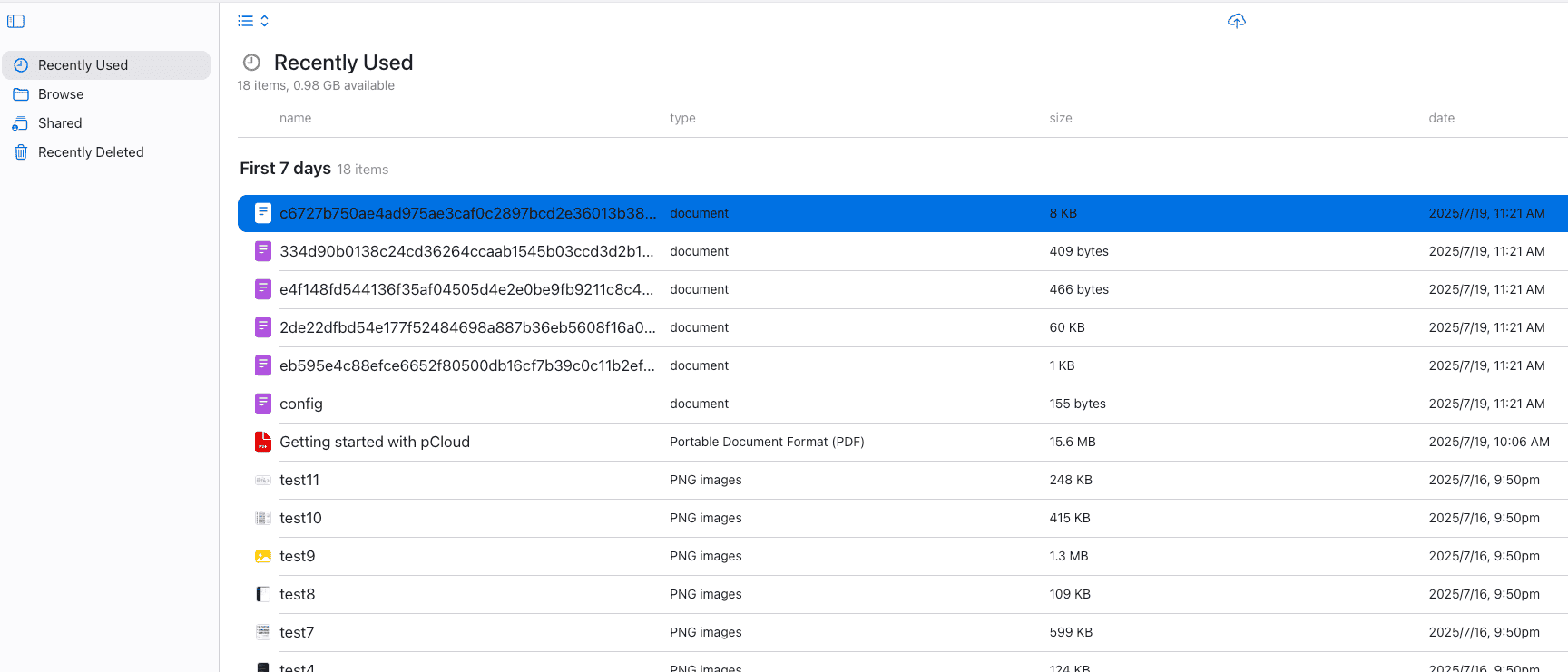
Step 2: Upload Files to MEGA
Now, head to MEGA’s web interface and log into your account. If you're new to MEGA, you can sign up for free and instantly gain access to 20 GB of encrypted cloud storage.
Once logged in, click the "File Upload" or "Folder Upload" button from the top menu, or simply drag and drop your unzipped files and folders directly into the browser window. MEGA will begin uploading them securely, using client-side encryption.
To keep things neat, recreate your original folder structure if necessary, especially if you plan to use MEGA’s desktop sync application later.
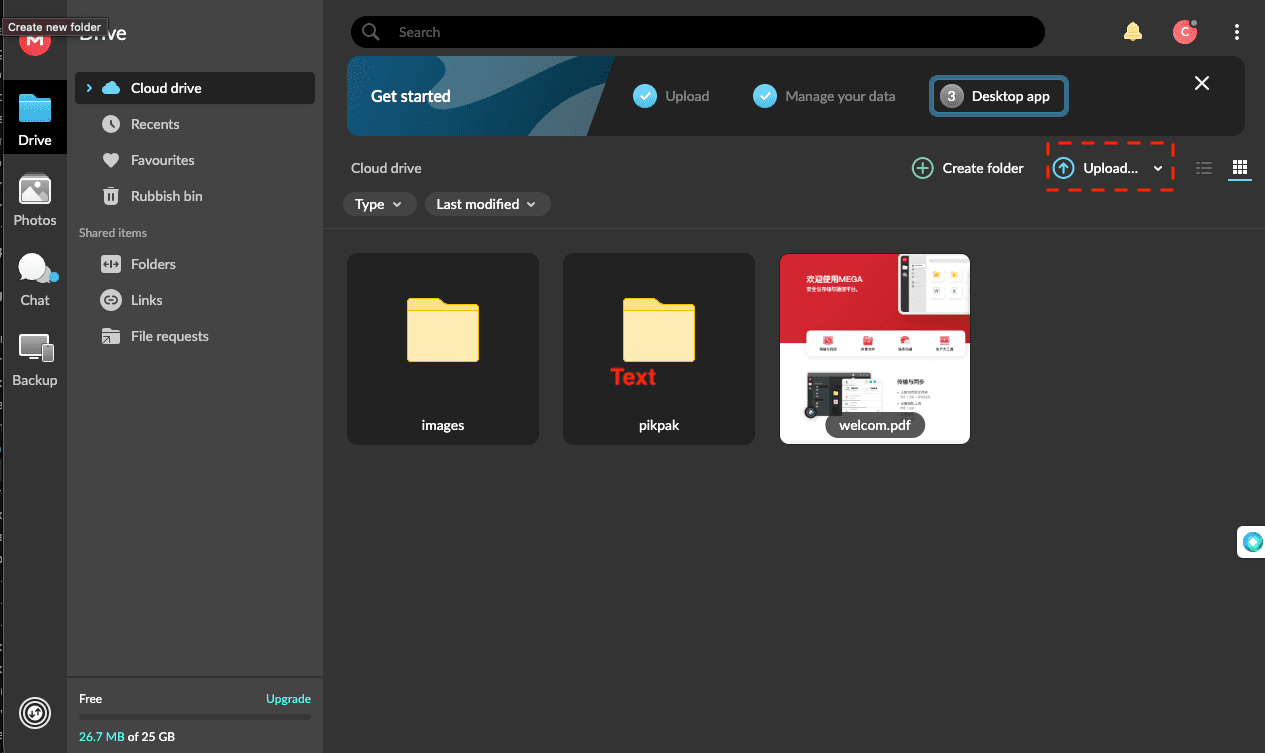
While this manual upload method works well for light transfers and quick backups, it may feel slow if you’re moving gigabytes of data or nested folders. For complex or recurring transfers, tools like CloudsLinker offer a more seamless experience.
Method 2: Transfer Using Your iPhone
Step 1: Open the MEGA App and Start Uploading
On your iPhone, install the MEGA app from the App Store if you haven’t already. Once installed, log into your account. Tap the “+” icon, usually located at the bottom-right corner of the screen. Then select “Upload files” to trigger the iOS file picker.

Step 2: Choose Files from iCloud Drive
In the file picker, tap “iCloud Drive” under the Locations section. From there, you can navigate through your folders and select the files you want to transfer. Files not stored locally on your iPhone may briefly take time to load before the upload begins.

This method is particularly handy when you're on the go and need to move individual documents, images, or small folders directly from your phone. With Apple’s native Files app integrated into the upload workflow and MEGA’s end-to-end encryption, your transfer remains both simple and secure. For larger transfers or folder hierarchies, using a desktop method may be more efficient.
Method 3: Command-Line Transfer with Rclone
Step 1: Install Rclone and Configure Your Cloud Remotes
If you're comfortable with terminal commands and prefer precise control over your transfer, Rclone is a robust, open-source tool that supports both iCloud Drive and MEGA as storage backends.
First, download the latest version of Rclone from the official site. Then, open a terminal window and
initialize configuration with:
rclone config. This command will guide you through creating remote connections to your
cloud accounts.
- Accessing iCloud Locally: On macOS, you can directly point Rclone to
~/Library/Mobile Documents/com~apple~CloudDocsto interact with your locally synced iCloud Drive. - Using iCloud as a Remote: Rclone includes experimental support for iCloud Drive as
a native remote. During
rclone config, chooseicloudand follow the prompts. Visit the iCloud setup documentation to understand token generation and authentication requirements. - Adding MEGA: Select
megaas your target remote. You'll be prompted for your MEGA email and password. Rclone encrypts credentials locally and supports 2FA if needed.
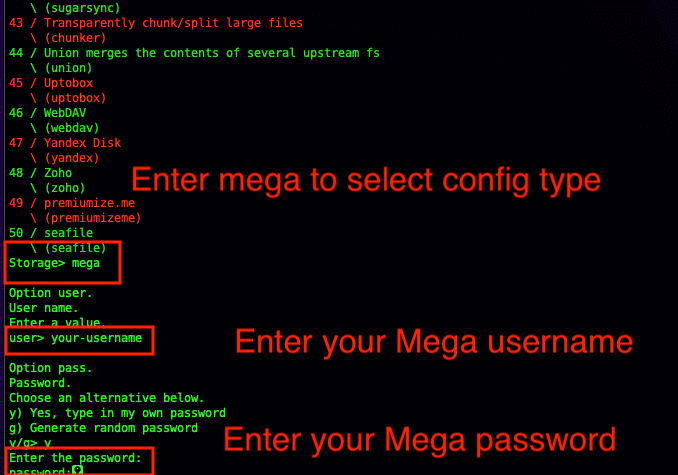
Step 2: Execute the File Transfer
Once both remotes are ready, initiate the transfer using a command like this:
rclone copy "~/Library/Mobile Documents/com~apple~CloudDocs" mega:iCloudToMega --progressrclone copy icloud:/Documents mega:iCloudToMega --progress
These commands copy your iCloud Drive files—either from your local folder or directly from the iCloud
backend—into a MEGA folder called iCloudToMega. To preview results without making changes,
use the --dry-run flag. You can also filter specific files with --include or
--exclude.
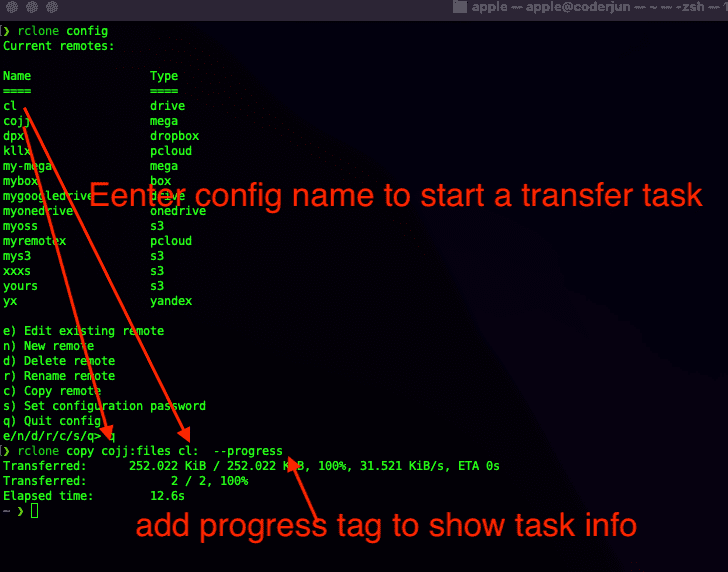
Rclone is ideal for power users who need scheduled, efficient, or large-scale transfers. It also supports logging, retries, bandwidth throttling, and automated sync via cron jobs or system schedulers. For detailed options on MEGA, visit the Rclone MEGA documentation.
Method Four: Cloud-to-Cloud Transfer with Cloudslinker
Overview: Migrate iCloud Drive to MEGA Without Downloads
Cloudslinker
is a streamlined cloud-to-cloud transfer solution that lets you move files directly between storage
platforms—without consuming your local internet bandwidth. It supports over 40+ cloud
services, including iCloud Drive and MEGA, and runs entirely
online for uninterrupted transfers.
Step 1: Log in to Cloudslinker
Navigate to app.cloudslinker.com and log in or sign up for free. On the dashboard, click "Add Cloud". Start by selecting iCloud Drive and sign in using your Apple ID and password. If 2FA is enabled, you'll need to enter the verification code sent to your device.
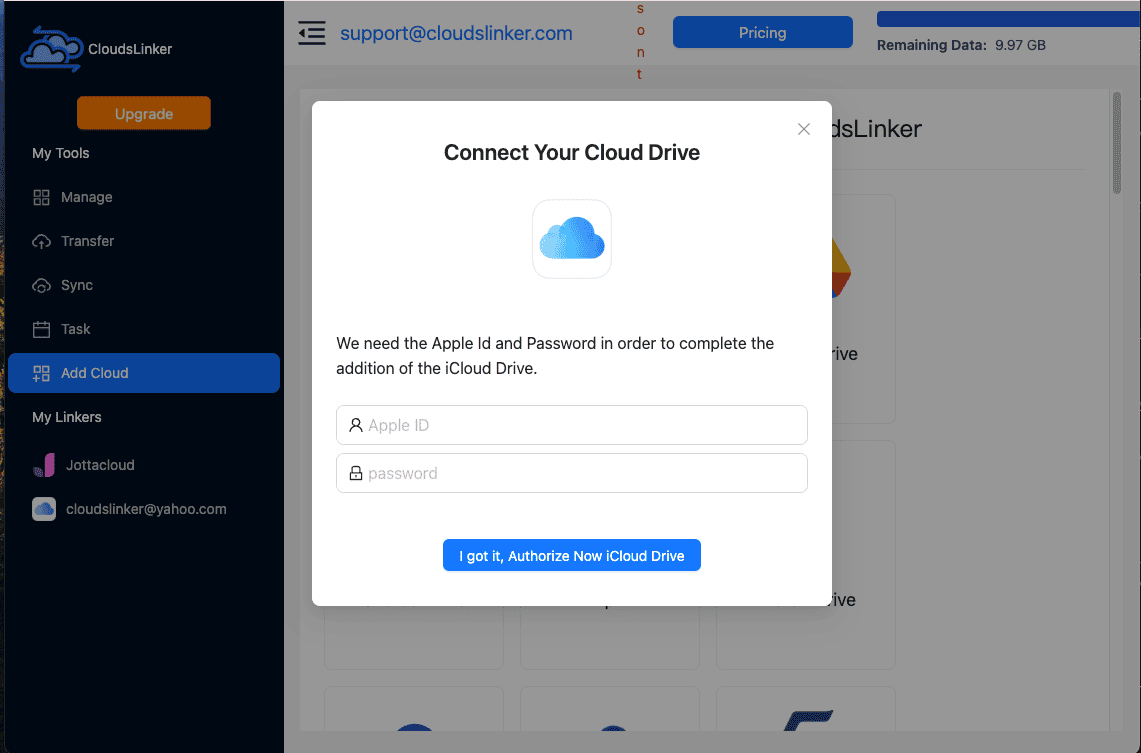
Step 2: Add MEGA Cloud
Now click "Add Cloud" again, and choose MEGA from the list. You’ll be asked to enter your MEGA login—either your email address or username—along with your password. Once entered, MEGA will be instantly linked as a cloud destination.
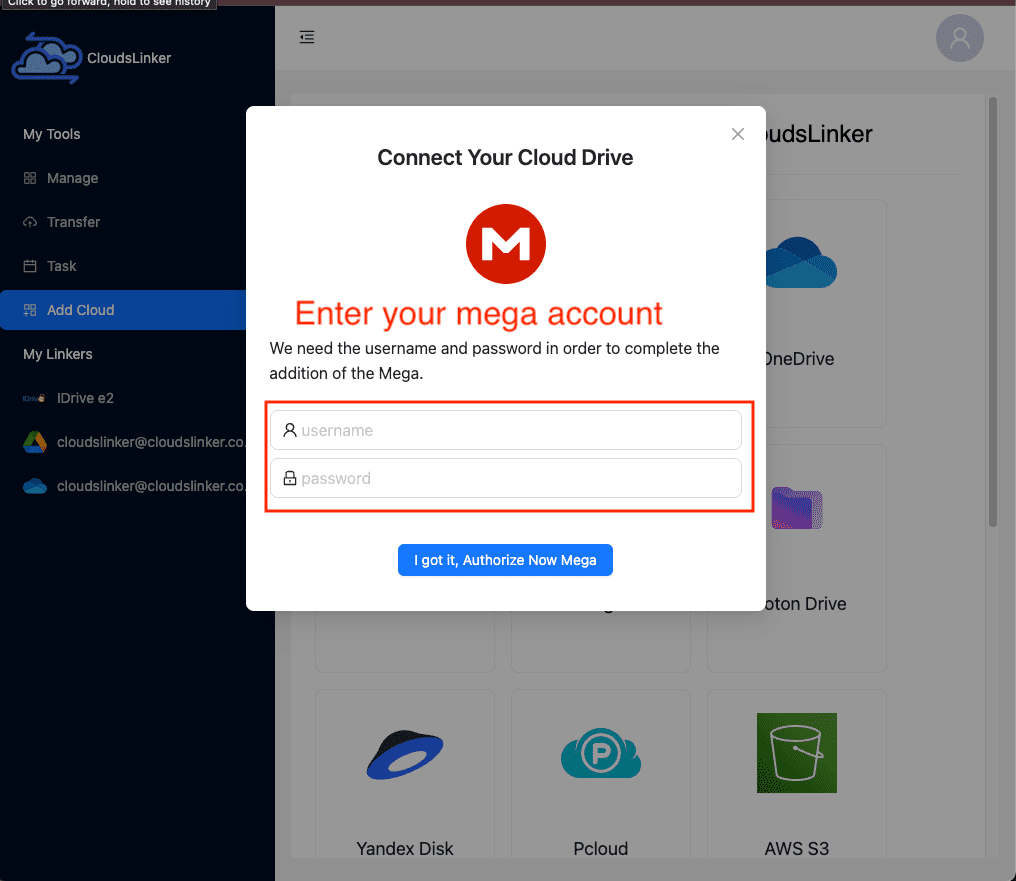
Step 3: Set Up the Transfer
Head to the Transfer tab. Set iCloud Drive as the source, and MEGA as the destination. You can select entire folders or specific files. Use the folder preview pane to double-check your structure before launching the task.

If needed, enable filters to exclude certain file types or only migrate recently modified items. This helps optimize your storage and reduce transfer time.
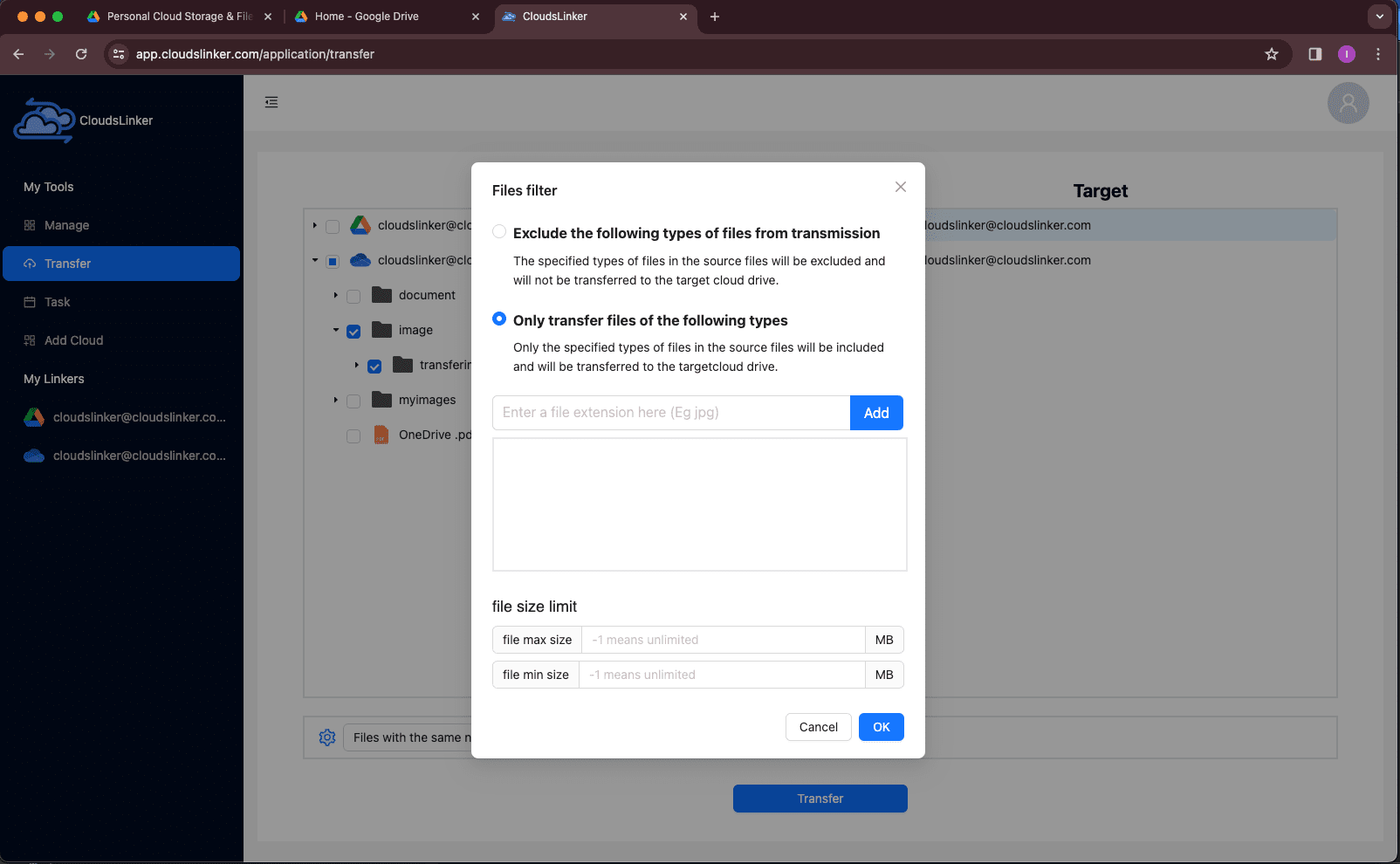
Step 4: Track the Migration
Your migration will appear in the Task List. You can monitor progress live, pause and resume, or re-run if anything fails. Files that are unsupported or locked will be clearly flagged.
Step 5: Review Summary
After the transfer is complete, Cloudslinker provides a detailed report showing which files were successfully moved, skipped, or failed. Your data is now safely stored in your MEGA cloud with no bandwidth drained from your device.
Whether you're a casual user or managing data at scale, Cloudslinker is an efficient, no-install-required tool to bridge cloud ecosystems.
Need to Move Files Between Other Clouds?
Whether you're working with Google Drive, Box, OneDrive, or WebDAV, Cloudslinker makes data migration easy—no downloads, no installations, no headaches.
Comparing the 4 Ways to Transfer from iCloud Drive to MEGA
When it comes to migrating files from iCloud Drive to MEGA, each method has its own strengths. Your choice will depend on the volume of data, your comfort with technology, and whether you want speed, simplicity, or automation. The chart below breaks down the pros and cons to help you decide:
| Method | Ease of Use | Speed | Best Suited For | Uses Local Bandwidth | Skill Level |
|---|---|---|---|---|---|
| Web Browser (Manual) | ★★★★★ | ★★★☆☆ | Quick, simple transfers under 2 GB | Yes | Beginner |
| iPhone Upload via MEGA App | ★★★★★ | ★★★☆☆ | Mobile-first users uploading select files | Yes | Beginner |
| Rclone (Command Line) | ★★☆☆☆ | ★★★★★ | Automation, large batch scripts | Yes / No (remote iCloud option available) | Advanced |
| Cloudslinker (Cloud-to-Cloud) | ★★★★★ | ★★★★★ | Large folders, recurring sync, hands-free | No | Beginner |
If you're only transferring a handful of files, the browser or MEGA mobile app will do the trick with minimal fuss. More advanced users might opt for Rclone to enable scripting or integrate transfers into automated workflows. But for anyone seeking a fast, hassle-free, and bandwidth-free solution—Cloudslinker offers the best balance of power and simplicity.
Transferring files from iCloud Drive to MEGA can be simple—but there are some things to consider to avoid unnecessary hiccups, especially if you're moving large folders or relying on manual uploads:
- Ensure Files Are Downloaded Locally: If you’re accessing iCloud from Finder or using Rclone on macOS, make sure the files are physically stored on your device—not just referenced with cloud icons. Incomplete downloads won’t migrate properly.
- Browser Upload Limits: MEGA supports large file uploads, but web browsers may struggle with single files over 10 GB. For best results, use the MEGA desktop app or a service like Cloudslinker to bypass browser restrictions entirely.
- Be Aware of Internet Speed: Uploading directly from your device to MEGA will be limited by your local upload bandwidth. For large or time-sensitive transfers, consider a cloud-to-cloud tool that eliminates this dependency.
- Check Your MEGA Storage: A free MEGA account comes with 20 GB of storage, but transfers from iCloud can easily exceed that. Consider upgrading to a Pro plan if needed before migrating.
- Use Secure Tools: Always use services that offer encrypted transfers and token-based logins. Cloudslinker supports AES-256 encryption and does not store your passwords.
- Transferring Large Volumes? If you're dealing with hundreds of gigabytes or scheduling recurring transfers, use platforms that support queuing, retries, and background processing. Cloudslinker can resume jobs if your device disconnects or if a file fails mid-transfer.
Taking the time to prepare ensures your transfer runs without interruptions. Whether you're moving a single folder or migrating your entire cloud library, being mindful of these best practices makes the iCloud to MEGA transition seamless.
Frequently Asked Questions
Watch Our Step-by-Step Video Tutorial
Learn how to transfer files from iCloud Drive to Mega with our clear, visual walkthrough. This tutorial is perfect for anyone—whether you're new to cloud storage or just looking for the easiest method. We’ll guide you through every step, from accessing your files in iCloud to syncing them with Mega using various tools including Cloudslinker. Get expert tips, avoid common mistakes, and simplify your cloud migration process. Watch now and move your files with confidence!
Conclusion
We've covered four effective strategies to move your files from iCloud Drive to MEGA—each tailored to different user needs. If you're just moving a few documents, browser or iPhone uploads are quick and easy. Power users will appreciate the automation and speed of Rclone, while those seeking hands-off convenience will find Cloudslinker ideal—it works entirely in the cloud, so transfers run even when your device is offline. Whichever method you choose, your files can be safely moved, organized, and ready to access in your MEGA account with minimal hassle.
Online Storage Services Supported by CloudsLinker
Transfer data between over 44 cloud services with CloudsLinker
Didn' t find your cloud service? Be free to contact: [email protected]
Further Reading
Effortless FTP connect to google drive: Transfer Files in 3 Easy Ways
Learn More >
Google Photos to OneDrive: 3 Innovative Transfer Strategies
Learn More >
Google Photos to Proton Drive: 3 Effective Transfer Techniques
Learn More >











































